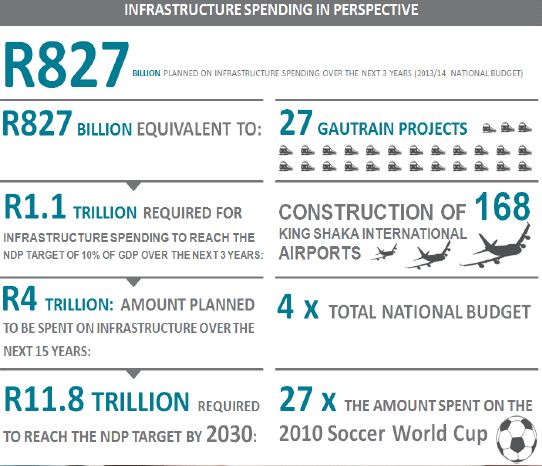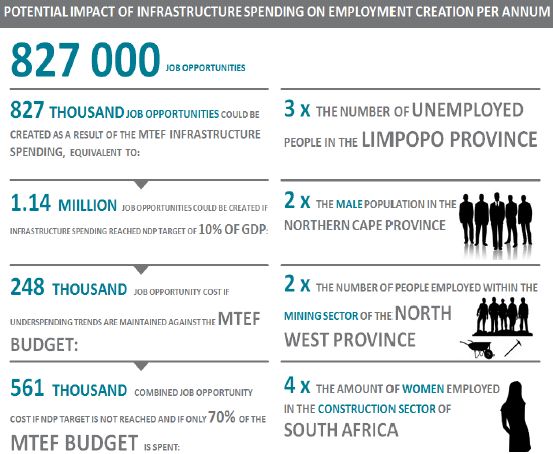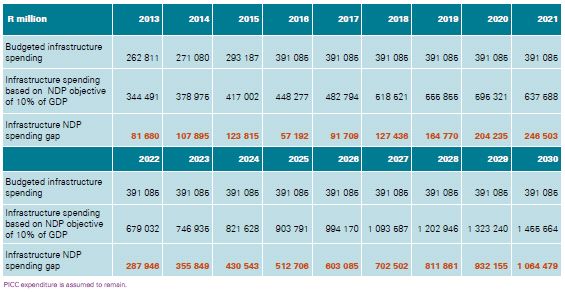Infrastructure spending is considered to be one of the major catalysts of economic growth, development and economic activity. It can be regarded as a mechanism of generating employment opportunities for millions of unskilled, semi-skilled and skilled workers. It is also widely considered to be one of the most important factors that foreign investors take into account when making investment decisions.
In his annual budget speech, Minister of Finance Pravin Gordhan provided insight into the South Africa government's planned infrastructure spending over the Medium Term Expenditure (MTEF) period, 2012/13 to 2015/16. Minister Gordhan announced that government plans to allocate R827 billion to public sector spending on infrastructure over the next three years. In addition to the planned MTEF spending, plans to roll out a much larger set of infrastructure projects, totaling spending of approximately R4 trillion1 over the next 15 years, was announced by the Presidential Infrastructure Coordinating Commission (PICC). This initiative forms part of government's broad plan to boost economic development and growth over the long term and to make the economy more competitive.
In his budget speech, Minister Gordhan also noted that decisions on which infrastructure projects to implement would be guided by the National Development Plan (NDP):
|
"The NDP provides clear guidelines for capital
investment priorities and the sequences of decisions required to
ensure that the country's infrastructure needs are provided for
in a sustainable, equitable, affordable and practical
manner." Minister Gordhan in the budget speech |
The alignment of infrastructure spending programmes with the NDP was widely welcomed, but South Africa's current spending on infrastructure is well short of the 10% objective set out by the NDP. South Africa's infrastructure spending levels are currently is closer to 8% of GDP.
As a country, we have only managed to spend 76% of our total planned infrastructure budget over the past three years. Addressing this underspending should be one of the first priorities the implementation of the NDP .
Budgeted infrastructure spending
Actual government spending on infrastructure over the 2010/11 to 2012/13 MTEF period has fallen far short of budget, with R642 billion spent over the past three years, against a target of R846 billion in 2010 (2010/11 budget review).
Looking forward to the 2013/14 to 2015/15 MTEF period, planned expenditure on infrastructure totals R827 billion. This accounts for more than 22% of the total MTEF budget period.

Of the R827 billion in planned expenditure, R430 billion is contributed by the spending plans of the general government and R400 billion is contributed by the spending plans of state owned companies such as Eskom, Transnet and other state- owned enterprises.
The general government share of expenditure was allocated for schools, hospitals, clinics, dams water and electricity distribution networks, electrification of over a million new homes, sanitation schemes, building more courtrooms and prisons, and improved bus, commuter rail and road links.
Most of the allocated spending falls under provinces and municipalities and these allocations include, amongst others:
- R150 million that have been allocated to implement a short-term action plan to address acid mine drainage;
- R42.3 billion that have been allocated to municipalities over the medium term to improve reticulation, sanitation and sewerage processing plants;
- R4.2 billion that have been allocated to Passenger Rail Agency of South Africa (PRASA) to improve the quality and capacity of its commuter rail services over the next three years, complementing revenue raised from user charges;
- R3 billion that have been allocated for social housing; and
- R30.3 billion that have been allocated to upgrade informal housing. Implementation challenges The challenge that South Africa faces, relates to roll-out and delivery of these projects. The budget speech acknowledged that spending programmes had become "a lot more ambitious" with the result that certain government departments struggled to spend their infrastructure budgets. As a result, stringent measures such as improved planning and management of strategic infrastructure projects, will be put in place to ensure that departments spend their allocated budgets for infrastructure as well as to combat corruption within government departments.
PICC plans
The PICC has announced the roll-out of a massive infrastructure programme, estimated to cost more than R4 trillion over the next 15 years. This includes the 18 Special Infrastructure Projects (SIPs) and private sector projects that are part of the strategic infrastructure projects, excluding those already at feasibility stage.
About 40% of these SIP projects are in the implementation phase, while others are still subject to feasibility studies.
|
" The infrastructure development programme has been a
valuable source of learning for government . In the year ahead, we
will fast track many of the projects that the PICC has announced.
" Jacob Zuma in the 2013 State of the Nation Address |
National Development Plan infrastructure spending objective
Infrastructure spending has been identified as one of the key pillars of the implementation of the NDP. According to the NDP, infrastructure development is not just essential for faster economic growth and higher employment, it also promotes inclusive growth, providing citizens with the means to improve their own lives and boost their incomes. Infrastructure is essential to development.
| The NDP has targeted public sector investment to reach 10% of GDP by 2030, in order to realise a sustainable impact on growth and provision of services. The infrastructure spending objective of 10% of GDP is in line with that of other BRICS countries are planning to spend of infrastructure. |

|
"You can't have sustainable development and
industrialisation without infrastructure that is of a different
kind." Deputy Public Works Minister Jeremy Cronin |
|
"Infrastructure is not just essential for faster
economic growth and higher employment. It also promotes inclusive
growth, providing citizens with the means to improve their own
lives and boost their incomes. Infrastructure is essential to
development." National Development Plan 2030 |
Linking objectives and plans: The infrastructure spending gap
With the implementation of the NDP yet to start, the question that arises is whether government's planned infrastructure spending of R4 trillion ( R5.5 trillion real 2013 values and assuming that the PICC funding continues to 2030) - which includes the planned MTEF infrastructure spending of R827 billion (R783 billion real 2013 values ), is sufficient to meet the NDP infrastructure spending objective of 10 % of GDP?
In answering this question, KPMG calculated the potential infrastructure spending gap if government increased their infrastructure spending to align with the NDP infrastructure spending objective. Moreover, we had to take into consideration the impact of the gap between the 5% GDP growth objective of the NDP and the current GDP growth rate of around 2.5%.
The results reveal that SA may not be able to successfully reach the NDP infrastructure spending objective. It is estimated that the infrastructure spending gap will amount to more than R297 billion between 2013/14 and 2015/16). This is approximately 38% more than the planned infrastructure budget. This gap is set to steadily increase to over R6 trillion for the period 2016/17 to 2029/30.
The spending gap is equivalent to an annual average of just under R100 billion over the next 3 years. This grows to over R500 billion remainder of the planned period.

The budget speech contained reference to increased infrastructure spending after 2015. The reality is, however, that government would need to accelerate total infrastructure spending far sooner if they want to cut back on the estimated spending backlog of R8.5 trillion to achieve the NDP objectives.
Therefore, for South Africa to meet the NDP infrastructure spending objective over the MTEF, we would have to increase planned infrastructure spending by 38% over and above the current budget levels. Over the longer term, we would need to increase infrastructure spending by over 1.5 times the current planned spending set out in the PICC plans.

Employment impact of planned and targeted infrastructure spending
In order to estimate the potential employment impact of the planned infrastructure expenditure versus the NDP infrastructure objective, KPMG modelled two scenarios.
The first scenario looked at the impact of the planned MTEF infrastructure spending on employment creation, while the second scenario looked at the potential impact should we be able to meet the NDP infrastructure spending objective over the same period.

|
"This year we decided to single out infrastructure for
special focus ... our view is that infrastructure development is a
catalyst to sustainable economic development and to the improvement
of the quality of life of our people in a most fundamental
way," President Jacob Zuma during a recent Infrastructure Development Summit |

|
"Infrastructure is an enabler of economic growth -
inflating its role beyond this is not sustainable" Lullu Krugel, Senior Economist, KPMG South Africa |
Potential employment impact results: bang for the infrastructure spending buck
Based on the planned MTEF infrastructure spending, and provided that government will successfully spend the entire infrastructure budget, it is envisioned that the result of the infrastructure spending projects could create approximately 2.4 million job opportunities, or provide employment for 2.4 million people for one year over the next 3 years. This is equivalent to an average of over 800 thousand job opportunities per annum.
On the other hand, in the event that government succeeds in achieving the NDP infrastructure spending objective between 2013/14 and 2015/16, potential job opportunities or employment for 3.4 million people for one year, averaging close to 1.1 million opportunities per annum over the 3 years period, could be created.
These job opportunities include direct employment through the infrastructure project, indirect employment opportunities due to spending in other sectors such as suppliers of cement and steel to these projects, and the induced or knock-on effects resulting from, for example, workers employed at these projects spending their income on food and clothing and, as such, creating additional employment opportunities for retailers.

Impact on current unemployment figures
According to the latest Quarterly Labour Force Survey (Quarter 4 2012) published by Statistics South Africa, South African economy currently employs more than 13.5 million people. Should the proposed MTEF infrastructure spending create 827 thousand jobs per annum, this would result in decrease in the current unemployment rate from 24.9% to as low as 20.3%, if we assume no job losses in other sectors. On the other hand, should government succeed in achieving the NDP infrastructure spending objective of 10% of GPD between 2013/14 and 2015/16, the current unemployment rate could decrease from 24.9% to as low as 18.6%, once again if we assume no job losses in other sectors. Although it is an unlikely scenario that there would be no job losses in other sectors of the economy, it is still important to take note of the positive impact that infrastructure spending could have in reducing unemployment.
With a significant portion of the infrastructure expenditure taking place within the construction sector, a large share of the employment opportunities should be created in this sector. Employment opportunities in the construction sector are typically temporary in nature and would usually only last for the duration of the construction phase. However, even though the jobs may be considered temporary in nature, it is important to keep in mind that the experience that workers could gain on these projects, would make them more employable in future.
On the other hand, the indirect and induced employment impacts that originates from the initial infrastructure expenditure, could often create more sustainable jobs, as the country will permanently be on a higher growth path that could support more jobs.
Impact on NDP employment objectives
The NDP aims to create 11 million jobs by 2030 through promoting employment in labour-absorbing industries and boosting both exports and competitiveness. Based on the analysis, up to 1.1 million sustainable jobs could be added on the back of infrastructure spending in line with the NDP. This could impact long term NDP job creation objective by up to 10% to 9.9 million jobs.
In the short term, however, it is likely that there will be a shortfall of at least 170 000 sustainable jobs if compared to the NDP objective to create 1 million sustainable jobs through public sector employment programmes by 2015.
|
"It was also imperative to improve the way the state
ran strategic infrastructure projects and to tackle
corruption" Pravin Gordhan, Budget speech 2013 |
THERE IS HOWEVER, ANOTHER SIDE TO THIS COIN...
Given the South African government's track record regarding spending on infrastructure, certain elements need to be considered to determine whether or not government would be able to achieve on the job creation impacts from the planned MTEF and NDP spending objective in relation to infrastructure.
In the past, we were not able to spend what we have planned...
The latest Expanded Public Works Programme II Progress Report revealed that the programme had created 643 116 job opportunities in the 2011 financial year. This is substantially less than the approximately 827 000 annual average job opportunities based on the planned MTEF expenditure. The main reason for this difference could be underspending due to planning and funding allocation inefficiencies.
In the budget speech, it was acknowledged that certain government departments were struggling to spend their full infrastructure budgets and that government's ability to spend was also not improving "fast enough". In 2012/2013, government departments only managed to spend around 68% to 70% of their infrastructure budgets. Thus, the full employment benefits from infrastructure spending , could continue to be limited to what we are able to spend.
In addition, the longer we take to reach the NDP objective, the more significant the impact on job opportunities created will be in the longer term. The impact of these scenarios are summarised in the table below.

APPENDIX 1 - ZOOMING INTO THE NUMBERS
The table below provides a detailed breakdown of the annual infrastructure spending shortfall that would occur if government failed to increase their infrastructure spending to align with the NDP objective.
As seen in the table below, over the first five years the infrastructure spending gap is expected to be fairly small, ranging from about R80 billion and R124 billion. This implies an annual shortfall of approximately 30% of the planned expenditure. This gap is, however, set to increase steadily over the long term with shortfalls ranging from R130 billion to more than R1 trillion over the period 2018/19 to 2029/30. The latter is equivalent to the annual shortfall more than 160% of the planned infrastructure expenditure.

Footnotes
1 The R4 trillion is based on real terms (2012 prices)
2 For ease of comparison all values where converted into 2013 prices and this is reflected in the table . The Implication of this is that the real values will be different to that reported in the budget speech and PICC planning document once converted to the same base year
3 A detailed breakdown of the infrastructure spending gap can be found in Appendix A of the report
4 Any expenditure that occurs outside of the country is essentially a considered a leakage out of the country therefore excluded from the economic impact model inputs.
The content of this article is intended to provide a general guide to the subject matter. Specialist advice should be sought about your specific circumstances.
